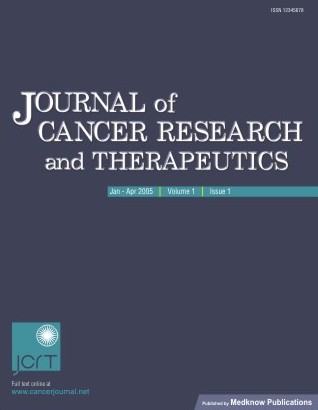
|
Journal of Cancer Research and Therapeutics
Medknow Publications on behalf of the Association of Radiation Oncologists of India (AROI)
ISSN: 0973-1482 EISSN: 1998-4138
Vol. 7, Num. 3, 2011, pp. 384-385
|
Journal of Cancer Research and Therapeutics, Vol. 7, No. 3, July-September, 2011, pp. 384-385
Letter to the Editor - Documenting a Case
Unusual clinical and radiological presentation of metastatic choriocarcinoma to the brain and long-term remission following emergency craniotomy and adjuvant EMA-CO chemotherapy: Response to the Letter
Ravi Dadlani1, Sunil V Furtado1, Nandita Ghosal2, Alangar S Hegde1
1 Department of Neurosurgery, Sri Satya Sai Institute of Higher Medical Sciences, Bangalore, India
2 Department of Pathology, Sri Satya Sai Institute of Higher Medical Sciences, Bangalore, India
Correspondence Address: Ravi Dadlani, Department of Neurosurgery, Sri Sathya Sai Institute of Higher Medical Sciences, EPIP area, Whitefield, Bangalore- 560 066, India, ravi.dadlani@gmail.com
Code Number: cr11100
PMID: 22044836
DOI: 10.4103/0973-1482.87026
Sir, We read with great interest the letter in response to our article "Unusual clinical and radiological presentation of metastatic choriocarcinoma to the brain and long-term remission following emergency craniotomy and adjuvant EMA-CO chemotherapy". [1] We thank the authors for their pertinent observations and queries. Following are my points in clarification for their queries:
- In response to the fact that a second surgery was undertaken in the presence of multiple systemic metastases: Ours is a tertiary neurosurgical institute with no Oncology department. The patient had delivered a child more than one year prior to the neurological presentation. Even in the presence of multiple organ involvement, the Gestational Trophoblastic Disease (GTD) would be very low on our clinical differential diagnosis. The beta-Human Chorionic Gonadotropin (ß-hCG) is also not a routine test undertaken at our institute. I, however, agree that if the clinical course was more suggestive of a choriocarcinoma, the second surgery would have possibly been redundant. At our center, all cancer patients are referred to another institute for non-surgical management. All patients are required to have a histological evidence (all neurological or metastases) in order to enable them to avail further treatment such as radiotherapy or chemotherapy.
- The term ′adjuvant′ has been used purely from the neurosurgeon′s perspective since, in this case, the emergent surgery was for the hematoma, which was life saving, and not from the perspective of an oncologist.
- The EMACO regimen was instituted at a regional Oncology center. The apparent irregularities in the course are due to three reasons: (1) On two occasions, the patient developed complications from the chemotherapy with severe nausea, vomiting, and decreased blood count. The therapy was re- commenced after relative subsidence of the adverse effects. Such adverse effects are well reported in literature. [2] (2) The patient resided in a rural part of the country hundreds of kilometers away from the Oncology center and was very irregular with the chemotherapy, but still managed to complete seven courses of the EMACO regimen. (3) The time period of the ß-hCG assays reflects only the follow-up period of the patient at our OPD (and does not necessarily correspond to the courses of the chemotherapy), which was not always regular.
- The case illustrated by the authors in the letter, in response to our article, was interesting but is similar to other reports in literature in regards to this condition. What made our patient peculiar was that the ß-hCG level normalized from an initial alarming figure of over 6,00,000 IU/L; moreover, despite the very aggressive clinical course of the disease (reflected in the weekly appearance of new intracranial lesions and multiple organ involvement), the patient had complete resolution. Various factors have been associated with a poor outcome in choriocarcinoma, viz.: (1) a clinicopathological diagnosis of choriocarcinoma; (2) a period extending beyond four months from pregnancy to treatment; (3) a pre-treatment ß-hCG >100,000 IU/L; (4) distant metastases to sites other than the lungs and vagina; (5) metastases preceded by term gestation; and (6) previous failed therapy. [2] Our patient demonstrated 5 of these 6 factors and still had long-term remission.
Although GTD may be relatively common entity for the Oncologist, for the neurosurgeon, it represents an unusual entity, especially with new lesions occurring every few days during the postoperative period.
References
| 1. | Dadlani R, Furtado SV, Ghosal N, Prasanna KV, Hegde AS. Unusual clinical and radiological presentation of metastatic choriocarcinoma to the brain and long-term remission following emergency craniotomy and adjuvant EMA-CO chemotherapy. J Cancer Res Ther 2010;6:552-6. Back to cited text no. 1 [PUBMED] [FULLTEXT] |
| 2. | Hiramatsu Y, Masuyama H, Ishida M, Murakami K, Sakurai M. Term delivery choriocarcinoma patient with brain and lung metastases successfully treated by etoposide, methotrexate, actomycin D, cyclophosphamide and vincristine (EMA- CO) chemotherapy. Acta Med Okayama 2005;59:235-8. Back to cited text no. 2 [PUBMED] [FULLTEXT] |
Copyright 2011 - Journal of Cancer Research and Therapeutics
|
